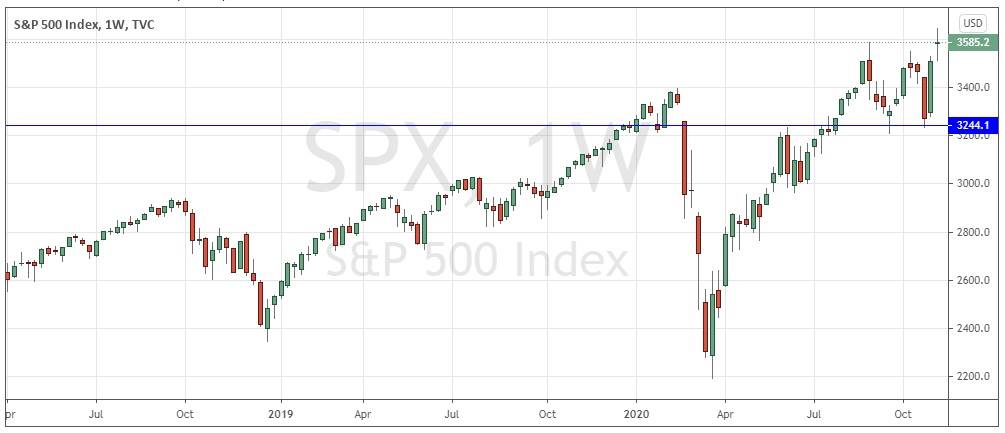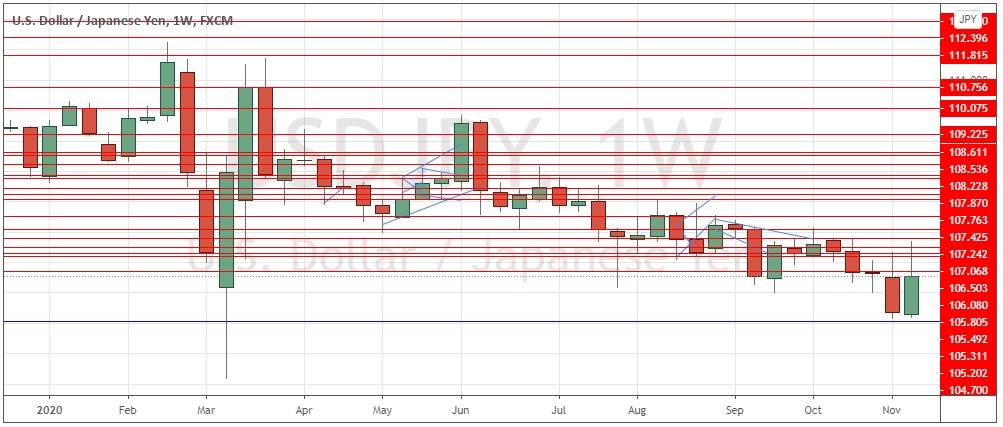The difference between success and failure in Forex trading is very likely to depend mostly upon which currency pairs you choose to trade each week and in which direction, and not on the exact trading methods you might use to determine trade entries and exits.
Big Picture 15th November 2020
In my previous piece last week, I saw the most attractive trade opportunities as likely to be in a short trade in the USD/JPY currency pair. This was not a great call as the price of the USD/JPY currency pair rose by 1.17% over the week.
Last week’s Forex market saw the strongest rise in the relative value of the New Zealand Dollar and the strongest fall in the relative value of the Japanese Yen.
Fundamental Analysis & Market Sentiment
Last week was dominated by the aftermath of the U.S. elections in which the results as they stand give a clear victory to Joe Biden. President Trump is still refusing to concede and has alleged fraud, claiming he has won if only legal votes are counted. Although no results have been formally certified yet, all the major networks have called the race for Joe Biden, who has already been congratulated by most world leaders. Joe Biden seems to have won the popular vote by about 3 to 4%. Recounts are taking place in at least two states. Georgia’s recount is interesting, as it is being conducted by hand and Georgia used Dominion software to tabulate vote counts. If there was bias in Dominion, it could be revealed by the Georgia recount. If the hand recount in Georgia shows no meaningful change to the result, it may dampen speculation about Dominion.
Strangely, although Biden seems to have no chance to not be duly elected as the 46th President, it is still possible to place a bet on his becoming the next President and to receive a 5% payout.
Another notable feature of the election result was that the Democrats seem to have made either no gains or only very limited gains in congressional elections, and it seems quite likely that Republicans will retain control of the Senate, although this will be determined by run-off elections in Georgia in January. If the Democrats win these, then there may be a stronger economic stimulus package, which could boost the U.S. stock market and weaken the U.S. dollar.
Markets have seen a risk-on rally as the results of the Presidential election become clearer last week, although they are still disputed.
Another major story in the U.S. has been several consecutive days of new all-time highs in confirmed new coronavirus cases in the U.S.A. with daily numbers coming in at over the 150,000 mark and deaths continuing at well over 1,000 per day. Joe Biden has already pledged to make getting coronavirus under control one of his top priorities since claiming victory.
The big coronavirus stories globally right now are the sharp rise in deaths worldwide, and the fact that Pfizer seems to have a 90% effective vaccine almost ready. When this news was announced, stocks rallied very strongly before falling back. Stock markets generally remain bullish. The U.S. stock market rose last week, making its all-time record high weekly close.
Last Friday saw a record number of new cases confirmed globally, at 660,809. New cases are rising exponentially across the world. I already mentioned the situation is bad in the U.S. but in Europe it is even worse. Several European nations have imposed new lockdowns in an attempt to get the situation under control. The European Union is now reporting more daily cases and deaths than even the U.S.
Europe is leading the share of the global death toll, at about 44%, while the U.S.A. is accounting for approximately 16%, while Latin America has 19% of the total. The strongest growth in new confirmed cases is happening in Albania, Algeria, Austria, Azerbaijan, Belarus, Brazil, Bulgaria, Canada, Costa Rica, Croatia, El Salvador, Estonia, Finland, Georgia, Germany, Greece, Hungary, Indonesia, Iran, Italy, Japan, Jordan, Kenya, Kosovo, Latvia, Lebanon, Liechtenstein, Lithuania, Mali, Moldova, Montenegro, Morocco, North Macedonia, Norway, Pakistan, Panama, Poland, Portugal, Romania, Russia, Serbia, Slovakia, Slovenia, Turkey, U.S.A., Ukraine, the United Kingdom, and Uruguay.
The coming week is likely to bring a moderate level of activity to the Forex market. However, there is little high-impact economic data due over the coming week except releases from the Reserve Bank of Australia with their most recent Monetary Policy Meeting Minutes, U.S Retail Sales data, and Canadian CPI (inflation).
Technical Analysis
U.S. Dollar Index
The weekly price chart below shows the U.S. Dollar index printed a small, weakly bullish candlestick. It has a large upper wick, which is a bearish sign. Significantly, the long-term bearish trend has resumed, as the price is lower than it was both 3 and 6 months ago. Overall, next week’s price movement in the U.S. dollar looks likely to be downwards.
S&P 500 Index
The S&P 500 Index currency pair closed Friday at an all-time weekly high closing price, which is a bullish sign. However, the weekly candlestick is an indecisive doji. Nevertheless, this is a bull market just after a U.S. presidential election, so the price is likely to rise further. I want to see a daily close above 3600 before entering a long trade in this stock Index.
USD/JPY
The USD/JPY currency pair is in a long-term downwards trend but printed a strong weekly bullish candlestick with a large upper wick. This upper wick rejected an area of resistance at about 104.65, and the real body of the candlestick is more than double its recent average. This suggests the odds are good due to both trend and mean reversion factors that the price here will fall over the coming week. The price has already been falling at the end of the week on daily and shorter time frames.
Bottom Line
I see the best likely opportunities in the financial markets this week in taking a short trade in the USD/JPY currency pair and a long trade in the S&P 500 Index following a daily close above 3600.

